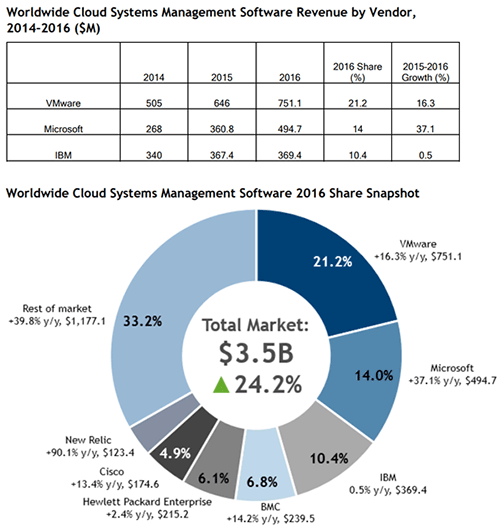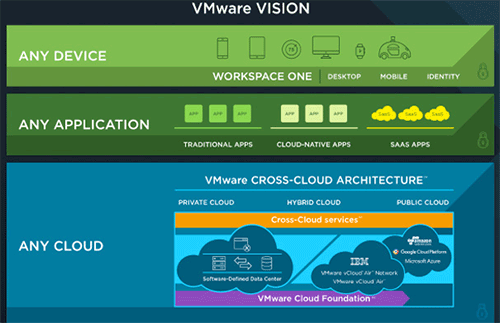關於本課程之相關考試:
VMware 已停止提供本課程的相關考試。
雖然學員已不能應考本課程的相關考試,
但學員仍能透過本課程所學的知識及實習,廣泛地應用於工作上。
|
推介服務:課堂錄影隨時睇 (在家觀看 = 0%,在校觀看 = 100%)
學員使用 WhatsApp、電話或本網頁報名,待本中心確認已為學員留位後,即可使用  繳付學費,過程簡便!
繳付學費,過程簡便!
* 各政府部門可使用 P Card 付款
如使用 P Card 繳付考試費,考試費需另加 2.5% 行政費
推介服務:課堂錄影隨時睇 (在家觀看 = 100%,在校觀看 = 0%)
學員使用 WhatsApp、電話或本網頁報名,待本中心確認已為學員留位後,即可使用  繳付學費,過程簡便!
繳付學費,過程簡便!
* 各政府部門可使用 P Card 付款
如使用 P Card 繳付考試費,考試費需另加 2.5% 行政費
注意! 客戶必須查問報讀學校的教育局註冊編號,以確認該校為註冊學校,以免蒙受不必要的損失!
根據 IDC – Worldwide Cloud Systems Management Software Market Shares 最新出版的研究報告指出,VMware 出品的雲端系統管理軟件持續多年成為行業內首位,並於近年來全球營收達到約 7.5 億美元 (即約 $58.5 億港元)。詳見下表:

“VMware's continued market leadership and growth reflected the company's ongoing efforts to offer customers a unified approach to cloud management monitoring, analytics, and automation.
Since the introduction of vCloud Suite and the launch of vSphere with operations management, VMware has used its management software portfolio to differentiate vSphere and help maintain overall corporate revenue growth, even as its core hypervisor market has matured and standalone hypervisor sales have flattened.
As many enterprises have opted to build private clouds using VMware technology, the company's management offerings have been widely deployed into cloud environments.” --- by IDC

VMware 的跨雲架構 (Cross-Cloud Architecture) 為客戶提供了雲的自由和控制。該架構利用新的公共和私有雲功能實現了 VMware 的混合雲端 (Hybrid Cloud) 策略,使客戶能夠在常用的操作環境和設備運行、管理、連接和保護其應用程序。
VMware 的跨雲架構為所有內部部署及雲端部署的商業應用程序 (Applications) 提供一致的部署方式、安全策略、可見性和管理規範 (Visibility & Governance)。
本課程將為學員逐一教授形成 VMware 的跨雲架構重要元素,例如 Software Defined Data Center (SDDC)、Software Defined Storage (SDS)、Software Defined Network (SDN)、Software as a Service (Saas)、Desktop as a Service (DaaS) 等等混合雲中心必用的技術,令學員對今時今日的混合雲端運作擁有根基而重要的知識! |
| 課程名稱: |
VMware VCA Digital Business Transformation (VCA-DBT) 國際認可證書課程
- 簡稱:VMware VCA Training Course |
| 課程時數: |
合共 54小時 (共 18 堂),共 1 科 |
| 適合人士: |
對虛擬數據中心運作 / 混合雲端有興趣的任何人士 |
| 授課語言: |
以廣東話為主,輔以英語 |
| 課程筆記: |
本中心導師親自編寫英文為主筆記,而部份英文字附有中文對照。 |
| 1. 模擬考試題目: |
本中心為學員提供約 50 條模擬考試題目,每條考試題目均附有標準答案。 |
| 2. 時數適中: |
本中心的 VMware VCA Digital Business Transformation (VCA-DBT) 國際認可證書課程時數適中,有 54 小時。令學員能真正了解及掌握課程內容,而又能於 3 個月內考獲 VCA-DBT 國際認可證書。 |
| 3. Larry Chan 親自教授: |
Larry 具備了
20
年以上電腦、網絡、數據庫及保安系統的工作經驗,最近
20
年更於本中心全職教學。而於過往
20
年,Larry 更以統籌及設計角色參與本中心數百項 I.T. Service 的虛擬化過程,協助本中心節省了數以百萬計的 I.T. 運作成本。 |
| 4. Larry Chan 親身編寫筆記: |
Larry 親自編寫筆記,絕對適合考試之用,令你無須「死鋤」如字典般厚及不適合香港讀書格調的書本。 |
| 5. 免費重讀: |
傳統課堂學員可於課程結束後三個月內免費重看課堂錄影。 |
VMware 已公佈考生必須通過以下 1 個 VCA-DBT 相關科目的考試,便可獲發 VCA-DBT 國際認可證書:
| 考試編號 |
科目名稱 |
| 1V0-701 |
VMware Certified Associate - Digital Business Transformation (VCA-DBT) |
註:自 2018 年 1 月起,此科目可安坐家中,上網應考。
https://mylearn.vmware.com/mgrReg/plan.cfm?plan=103218&ui=www_cert
報考時登入以上網站獲取 VMware Candidate ID,然後 "Register Now" 便會自動前往 VUE 網站登記欲報考之科目 (1V0-701)、繳付考試費 (US$125) 隨即開始進行考試。
考試題目由澳洲考試中心傳送到你家中應考的電腦,考試時以電腦作答。
所有考試題目均為英文,而全部的考試題目為選擇題。
考試完成起計數個工作天後,VMware 會以電郵通知你的考試成績,若為合格,你便可依照電郵內的指示登入 vmware.com 並下載您的證書。
若考試不合格便可重新報考,無須等候,不限次數。欲知道作答時間、題目總數、合格分數等詳細考試資料,可瀏覽本中心網頁 "各科考試分數資料"。 |
課程名稱:VMware VCA Digital Business Transformation (VCA-DBT) 國際認可證書課程
- 簡稱:VMware VCA Training Course |
1. Introduction to Software Defined Data Center
1.1 Data Center Virtualization offered by VMware
1.2 Virtualization in the Past and Present
1.3 Physical and Virtual Data Center Components
1.4 Differences between Physical and Virtual components
1.5 Physical to Virtual Conversion
1.6 Benefits of Using Virtualization
2. VMware Solutions to Data Center Virtualization
2.1 Availability Challenges
2.2 VMware Availability Technologies
2.3 vMotion
2.4 Storage vMotion
2.5 vSphere Data Protection
2.6 vSphere Fault Tolerance (FT)
2.7 vSphere High Availability
2.8 Site Recovery Manager
2.9 Multisite Stretched Cluster
2.10 Disaster Recovery with vCenter Site Recovery Manager
2.11 Virtual Machine Snapshots
2.12 Management Challenges
2.13 Scalability Challenges
2.14 Optimization Challenges
3. Storage in a VMware Environment
3.1 Physical Storage v.s. Virtual Storage
3.2 About Shared storage
3.3 VMware Storage Types
3.4 Virtual Machine File System
3.5 Increasing a VMFS Datastore capacity
3.6 Disk Provisioning
3.7 Virtual Volume (VVOL)
3.8 Storage Policy Based Management (SPBM)
4. VMware’s Virtual Networking Environment
4.1 Physical and Virtual Network
4.2 Standard Virtual Switch
4.3 Port Groups 120
4.4 Standard Switch Properties 124
4.5 Traffic Shaping in Standard Switch
4.6 vSphere Distributed Switch (VDS)
4.7 VDS Components and Architecture
4.8 Creating a Distributed Switch for Virtual Machine traffic
4.9 Network I/O Control
4.10 Traffic Shaping Policy in a Distributed Switch environment
4.11 Port Mirroring
4.12 Traffic Filtering and Marking Policy
4.13 Switch Discovery Protocol
5. Virtual Networking in vSphere
5.1 Physical and Virtual Network
5.2 Standard Virtual Switch
5.3 Port Groups
5.4 Standard Switch Properties
5.5 Traffic Shaping in Standard Switch
5.6 vSphere Distributed Switch (VDS)
5.7 VDS Components and Architecture
5.8 Creating a Distributed Switch for Virtual Machine traffic
5.9 Network I/O Control
5.10 Traffic Shaping Policy in a Distributed Switch environment
5.11 Port Mirroring
5.12 Traffic Filtering and Marking Policy
5.13 Switch Discovery Protocol
5.14 Backing up a Virtual Distributed Switch
6. Overview of VMware's Network Virtualization
6.1 Network Virtualization in Software Defined Data Center (SDDC)
6.2 VMware NSX Primary Use Cases
6.3 The NSX Network Virtualization Solution
6.4 NSX Functional Components
6.5 VXLAN Encapsulation
6.6 VXLAN Encapsulated communication
6.7 Transport Zone
6.8 ESXi Hypervisors with VDS
6.9 User Space and Kernel Space
6.10 NSX Edge Services Gateway
6.11 NSX Distributed Firewall (DFW)
7. NSX Functional Services
7.1 Multi-Tier Application Deployment Example
7.2 Logical Switching
7.3 Replication Modes for Multi-Destination Virtual Machine Traffic
7.4 Controller Tables population
7.5 Unicast Traffic (Virtual to Virtual Communication)
7.6 Unicast Traffic (Virtual to Physical Communication)
7.7 Logical Routing
7.8 Routing Capabilities of NSX
7.9 BGP and NSX Connectivity Options
7.10 Enterprise Routing Topology
7.11 Scalable Topology for Service Providers
7.12 Unsupported Topologies and misplacements of DLR
7.13 Logical Firewalling and Security Services
7.14 Network Isolation
7.15 Network Segmentation
7.16 Taking Advantage of Abstraction
7.17 Advanced Security Service Insertion, Chaining and Steering
7.18 Consistent Visibility and Security Across Physical and Virtual
7.19 Introduction to Service Composer
7.20 Introduction to Intelligent Grouping
7.21 Intelligent Grouping – An Example of Efficiency
7.22 Using Security Tags
7.23 Introduction to Security Policy
7.24 Anatomy of a Security Policy
7.25 Micro-Segmentation with NSX DFW and Implementation
7.26 Logical Load Balancing
7.27 Virtual Private Network (VPN) Services
8. NSX Design Considerations
8.1 Topology Independent Design with NSX
8.2 VLAN Connectivity with NSX
8.3 NSX Deployment Considerations
8.4 vCenter Design with NSX
8.5 VDS Design in an NSX Domain
8.6 VDS Uplinks Connectivity NSX Design Considerations
8.7 ESXi Host Traffic Types
8.8 Host Profiles for VMkernel Interface IP Addressing
8.9 VMware vSphere 6.0 based design
8.10 Edge Design and Deployment Considerations
8.11 NSX Edge Deployment Considerations
8.12 VLAN Design for Peering with Physical Routers
8.13 NSX Layer 2 Bridging Deployment Considerations
8.14 Conclusion to NSX Network Virtualization
9. Introduction to VDI and VMware Horizon
9.1 About Virtual Desktop Infrastructure
9.2 How does a user connect to their desktop
9.3 VDI Desktops vs Physical Desktops
9.4 Server-based computing and VDI
9.5 Delivering published applications with SBC
9.6 Delivering published desktops with SBC
9.7 VDI, published applications, or desktop sessions
9.8 VMWare VDI History
9.9 VMware Horizon 6 editions
10. Horizon View 6 Architecture
10.1 The Horizon View core components
10.2 A high-level architecture overview
10.3 The Horizon View Connection Server
10.4 The Horizon View security server
10.5 The Horizon View replica server
10.6 Horizon View Composer and linked clones
10.7 Full Clone vs Linked Clone
10.8 View Composer products
10.9 The Linked-Clone features and functions
10.10 View Persona Management
10.11 Managing USB devices in a virtual desktop
10.12 Filtering supported USB devices
10.13 ThinApp application virtualization
10.14 Antivirus for virtual desktop machines
10.15 The VMware vShield Endpoint architecture
10.16 The PCoIP protocol – delivering the desktop experience
10.17 Hardware-accelerated graphics in Horizon View
10.18 Virtual Shared Graphics Acceleration
10.19 Virtual Dedicated Graphics Acceleration
10.20 Unified communications support
10.21 Real-Time Audio-Video (RTAV)
10.22 Horizon View Clients
11. Designing a Horizon View Infrastructure
11.1 Proving the technology – from PoC to production
11.2 Proving the technology
11.3 The pilot phase
11.4 Designing a Horizon architecture
11.5 The Cloud Pod Architecture
11.6 Sizing the infrastructure
11.7 Sizing the desktop host servers
11.8 Memory sizing considerations
11.9 Networking considerations
11.10 Storage
11.11 Delivering high-end graphics
11.12 Sizing the virtual desktop machines
11.13 A Sample Design case study for Systematic Corporation
12. Deploying Horizon View Connection Server
12.1 Existing LAB Environment
12.2 SSL Certificate for Horizon View components
12.3 Installing, Configuring and Preparing Certification Authority
12.4 Installing Horizon View Connection Server
12.5 Post installation tasks of View Connection Server
12.6 Configuring Event Database for View Connection Server
13. Deploying Horizon View Security Server
13.1 Enrolling SSL Certificate for View Security Server
13.2 Installing and Pairing View Security Server
14. Deploying Horizon View Replica Server
14.1 Enrolling SSL Certificate for View Replica Server
14.2 Installing View Replica Server and Configuring View Replication
15. Deploying Horizon View Composer Server
15.1 Enrolling SSL Certificate for View Compser Server
15.2 Configuring Database and Prerequisites
15.3 Installing and View Composer to Horizon View Infrastructure
15.4 Adding vCenter Server and View Composer into Horizon View Infrastructure
16. The Horizon View Administrator console
16.1 Introduction to View Administration Web Interface
16.2 View Administrator Dashboard
16.3 Inventory
17. Building and Optimizing VDI Machine OS Images
17.1 Introduction to VDI Machine OS Image
17.2 Creating the VDI Gold Image Virtual Machine in vCenter
17.3 Installing standard applications and view agent for the Gold Image
17.4 VMware OS Optimization Tool
17.5 Post Optimization tasks
17.6 About Windows Activation
18. Configuring a GPU-Enabled Virtual Desktop
18.1 Configuring GPU enabled vCenter and vSphere VDI host
18.2 Configuring and Installing the GPU Enabled Virtual Machine
18.3 Installing Guest Operating System for GPU Enabled Virtual Machine
19. Deploying Desktop Pool with Linked Clones
19.1 Creating Snapshot for Linked Clones
19.2 Configuring a Linked Clone Desktop Pool
19.3 Entitling VDI Users to Desktop Pool
20 Deploying Horizon View Clients
20.1 Introduction to Horizon View Software Clients
20.2 Deploying Horizon View Software Client for Windows
20.3 Setup View Client for Internal Use
21. Implementing Persona Management
21.1 Introduction to Horizon View Persona Management
21.2 High level steps of implementing Horizon View Persona Management
21.3 Detail Steps of Configuring Horizon View Persona Management
21.4 More about updating Linked Clone desktop pool with Re-composition
22. Horizon View Blast Secure Gateway
22.1 Introduction to Blast Secure Gateway and HTML Access
22.2 Configuring HTML Access and Blast Secure Gateway
22.3 Using HTML Access with Blast Secure Gateway
23. Horizon View External Access
23.1 Introduction to View Security Server with Blast Secure Gateway
23.2 Configuring View Connection Server and Desktop Pool for external access
24. VMware Workspace Portal
24.1 Introduction to Workspace Portal
25. ThinApp
25.1 ThinApp Solutions and Features
25.2 Capturing and Packaging Windows Applications using ThinApp
25.3 Configuring ThinApp deployment with Horizon View
26. VMware Enterprise Mobility - AirWatch Cloud
26.1 AirWatch Solutions: BYOD
26.2 AirWatch Solutions: Container Management and Privacy Separation
26.3 AirWatch Solutions: Mobile Applications Management
26.4 AirWatch Solutions: Mobile Content Locker Collaboration
The course content above may change at any time without notice in order to better reflect the content of the examination.
|

